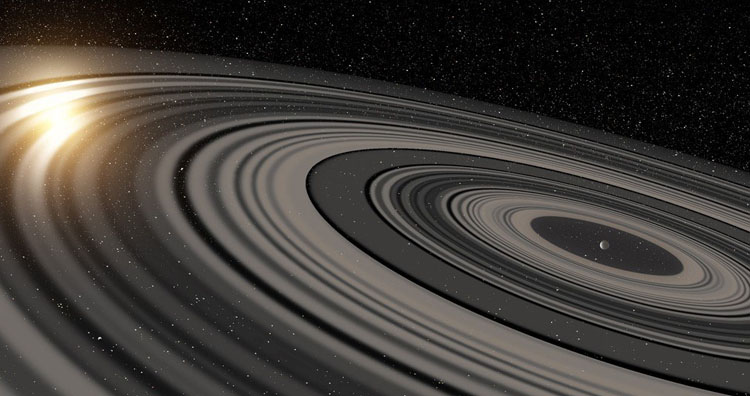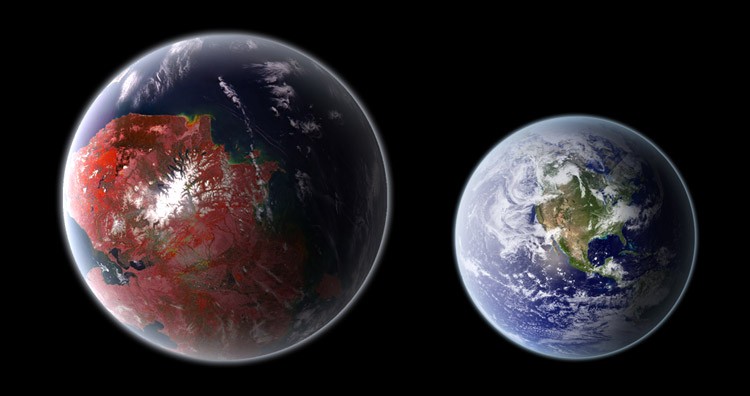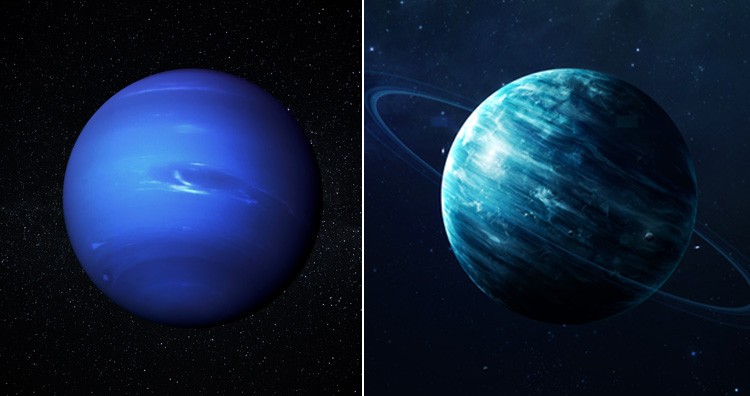Is the 9th planet in the solar system 10 times the size of Earth?
Planet 9

Scientists believe there is a ninth planet in our solar system, which is 10 times the size of Earth. The position of this planet is still not confirmed but it is certain that it exists thanks to its gravitational effect on other objects.
Also known as "Planet 9", it is 10 times more massive than Earth and moves along an elongated orbit at a distance 400 times the distance between Earth and the Sun. Planet 9's orbit is also probably 15 to 25 degrees off the main orbital plane of the solar system, where the rest of the planets move.
The idea of the existence of this new planet was proposed in 2014, and it quickly became popular among astronomers. This speculation is based on samples of objects in a debris ring in the outer belt known as the "Kuiper Belt."
It has been observed that the objects here are clumped together in a manner similar to the presence of gravity from some large object. Since this discovery, astronomers have tried to find a lot of evidence to support the existence of the 9th planet in the solar system.
However, what keeps us from saying for sure that this planet completely exists is our limited understanding of the Kuiper Belt.
J1407b

There is an exoplanet called J1407b, it has more than 30 rings around it, and each ring is tens of millions of kilometers in diameter. Its giant rings are 200 times larger than those of Saturn.
Saturn is the planet with the largest rings in our solar system, but its rings are too small compared to this exoplanet, but it is too far away to be able to detect it. observed directly.
J1407b was discovered in 2012, recent studies have shown that the ring system of this planet is 120 million km long (30 rings in total), and has the form of obscure dust particles. light with a total mass close to that of the Earth.
Scientists think that such giant rings were formed when these planets were young. Over a long period of time, the rings will thin out and disappear, until eventually it may only be left like the rings of Saturn today. Because of this, it is possible that our Saturn also had a very large ring before.
J1407b orbits a Sun-like star, but 95% of its light is blocked by this dense ring system. Astronomers have predicted that these rings will become significantly thinner in the next few million years.
Kepler-442b

According to an index developed in 2015, Earth is not the most habitable planet ever found. There is a rocky exoplanet called Kepler-442b, more than q thousand light-years away, roughly the same size as Earth. This planet has a habitable index of 0.836 while Earth is at 0.829.
Kepler-442b is an exoplanet, likely a terrestrial planet, orbiting in the habitable zone of the orange dwarf Kepler-442, approximately 1,206 light-years from Earth. The planet was discovered by NASA's Kepler spacecraft using the radial velocity method. NASA announced exoplanet confirmation on January 6, 2015.
The scale for determining the habitability of planets is based on the "Goldilocks Zone" - the exact distance from the planet to its sun - the distance that allows liquid water to exist. In addition, the new index takes into account the density of rocks, the element of the planets, as well as the eccentricity of their orbits and albedos. Accordingly, the planet Kepler-442b is thought to be more suitable for life than Earth.
Neptune and Uranus have oceans of diamonds

According to the researchers, it is possible that Neptune and Uranus have oceans of liquid diamond. Experiments conducted under high pressure simulating conditions on these gas giants show that diamond fragments can float on a sea of liquid carbon.
The study builds on detailed measurements of diamond's melting point - the first detailed measurements of diamond's melting point. Scientists conducted experiments to liquefy diamonds under high pressure and heat using a laser - diamonds are subjected to pressures 40 million times greater than that found at sea level in The earth.
Accordingly, when conducting experiments under similar conditions to the environments of Neptune and Uranus. The results showed that solid diamond fragments began to appear on the background of liquid diamond. They even float like icebergs on water.
And it is estimated that about 10% of Neptune and Uranus are made up of carbon. Therefore, it is possible to form oceans of diamonds on these two planets. But for now, that's still just a theory and exactly how true reality is, it remains to be seen by scientists who can reach the surface of these two planets.
You should read it
- Crazy idea: Create an atmosphere for Mars
- Discover the strange green planet HD 189733b outside the solar system
- Discover a new dwarf planet about the size of a Pluto in the Solar System
- NASA revealed the first studies of the planet's outer atmosphere
- The deviating object in the Kuiper Belt may be the 10th planet of the solar system
- Photos of the 9th planet in our solar system
- If 'stray' to any planet in the solar system, what is your chance of survival?
- The surface of Venus: Why is Venus the hottest planet in the solar system?
May be interested
- When can we determine the position of the '9th planet' in the solar system?
 the hidden days of the ninth planet are not observed while in the dark depths outside the solar system that can be counted. so when can we determine the position of the 9th planet in the solar system?
the hidden days of the ninth planet are not observed while in the dark depths outside the solar system that can be counted. so when can we determine the position of the 9th planet in the solar system? - The discovery of the 'Second Earth' can exist only 4.2 light-years away from Earth
 scientists at the european southern observatory (eso) have discovered an earth-like rock planet outside the solar system. in particular, it is only 4.2 light-years from earth and life can exist. with that distance, people can set foot on this planet in the near future.
scientists at the european southern observatory (eso) have discovered an earth-like rock planet outside the solar system. in particular, it is only 4.2 light-years from earth and life can exist. with that distance, people can set foot on this planet in the near future. - The surface of Venus: Why is Venus the hottest planet in the solar system?
 join us to find evidence that explains the question: why is venus the hottest planet in the solar system? please!
join us to find evidence that explains the question: why is venus the hottest planet in the solar system? please! - The interesting fact about the universe is not quite the same as what we thought
 round earth, mercury is the hottest planet and the sun is yellow. let's discover the truth about the solar system not exactly the same as what we think!
round earth, mercury is the hottest planet and the sun is yellow. let's discover the truth about the solar system not exactly the same as what we think! - NASA announced concussion: 7 Earth-sized planets could have life
 nasa has just announced the discovery of 7 planets of the same size and mass as the earth and together in a single star system - the trappist-1 star system 40 years away from us is probably the environment for live can exist.
nasa has just announced the discovery of 7 planets of the same size and mass as the earth and together in a single star system - the trappist-1 star system 40 years away from us is probably the environment for live can exist. - Space Science: The order of 8 (or 9) planets in the Solar System
 let's learn about the order of 8 (or 9) planets in our solar system!
let's learn about the order of 8 (or 9) planets in our solar system! - Mars: Overview of the 4th planet in the solar system
 how big is mars? what is the mass of mars? let's find out with tipsmake.com.com what you need to know about the red planet!
how big is mars? what is the mass of mars? let's find out with tipsmake.com.com what you need to know about the red planet! - Saturn, the most beautiful planet of the solar system through the Cassini spacecraft prism
 the cassini spacecraft was launched by nasa in 2004, after 13 years of flying around saturn it captured beautiful images of this mysterious planet.
the cassini spacecraft was launched by nasa in 2004, after 13 years of flying around saturn it captured beautiful images of this mysterious planet. - The distance from Earth to Jupiter - what is the largest planet of the solar system?
 do you know the distance from earth to jupiter - what is the largest planet of the solar system? let's tipsmake.com find out!
do you know the distance from earth to jupiter - what is the largest planet of the solar system? let's tipsmake.com find out! - How long does one day on the solar system planets last?
 the length of the day in each planet depends on its distance to the sun, the orbital cycle (the time the planet orbits the sun) and the astronomical cycle (the time it spins around the axis).
the length of the day in each planet depends on its distance to the sun, the orbital cycle (the time the planet orbits the sun) and the astronomical cycle (the time it spins around the axis).










 The Most Powerful Space Telescope Ever Built Will Look Back In Time To The Dark Ages Of The Universe
The Most Powerful Space Telescope Ever Built Will Look Back In Time To The Dark Ages Of The Universe Solar Storm is making landfall on Earth
Solar Storm is making landfall on Earth A meteor with a speed of 32,000 km / h is approaching Earth's orbit
A meteor with a speed of 32,000 km / h is approaching Earth's orbit The most beautiful meteor shower of the year and amazing astronomical phenomena in August
The most beautiful meteor shower of the year and amazing astronomical phenomena in August Stunning photos of the largest moon in the Solar System
Stunning photos of the largest moon in the Solar System Unusually large amount of methane detected on Saturn's moon: Is it alien life?
Unusually large amount of methane detected on Saturn's moon: Is it alien life?